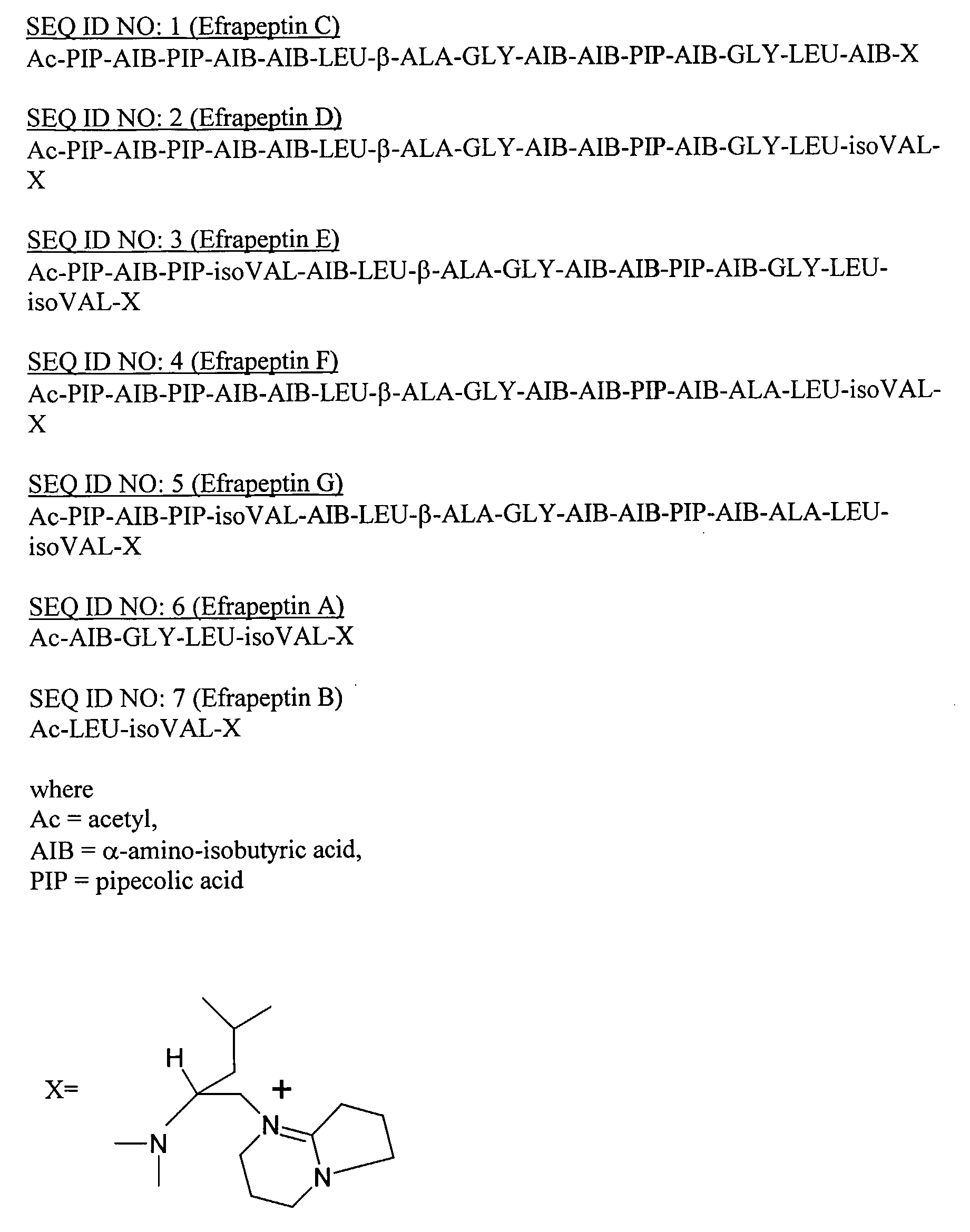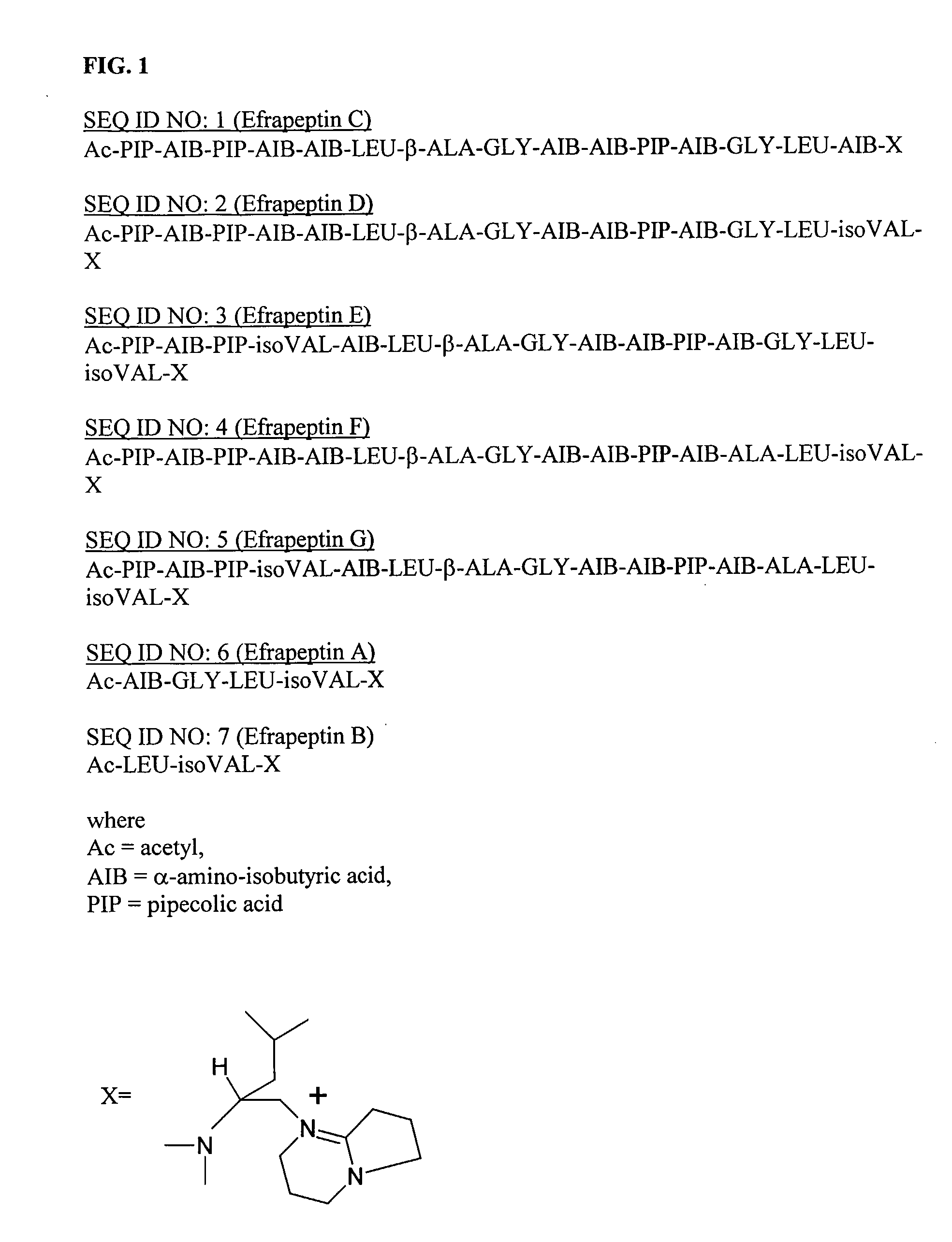Methods for Inhibiting Proteasome and Heat Shock Protein 90
a technology of proteasome and heat shock protein, which is applied in the direction of peptide/protein ingredients, peptide sources, drug compositions, etc., can solve the problems of increased protein degradation, poor prognosis, and upregulation of hsp27 in human cancers, so as to enhance the anti-tumor
- Summary
- Abstract
- Description
- Claims
- Application Information
AI Technical Summary
Benefits of technology
Problems solved by technology
Method used
Image
Examples
example 1
[0063] Inhibition of Chymotrypsin-Like Activity of 20S Proteasome by SEQ ID NO 2.
[0064] 0.1 μg of purified rabbit 20S proteasome (from Boston Biochem) were incubated for 30 min at 37° C. with 200 μM Suc-LLVY-AMC (from Sigma Aldrich) in the absence and presence of various concentrations of SEQ ID NO: 2 in 100 μL of assay buffer (50 mM Tris-HCl pH7.5, 0.04% SDS). After incubation, production of hydrolyzed AMC groups was measured using a multi-well CytoFluor™2300 Fluorescence Measurement System (Millipore) with an excitation filter of 380 nm and an emission filter of 460 nm. Reactions were performed in triplicates. Experiments were repeated multiple times. Data are presented as % of control fluorescence (absence of SEQ ID NO: 2) and shown as MEAN±SD.
[0065] SED ID NO: 2 inhibited chymotrypsin-like activity of purified 20S proteasome in a concentration dependent manner (FIG. 2).
example 2
[0066] Inhibition of Chymotrypsin-Like Activity of 26S Proteasome Present in HT-29 Whole Cell Extracts by SEQ ID NO 2.
[0067] 25 μg of whole cell extracts obtained from untreated HT-29 cells were incubated for 30 min at 37° C. with 200 μM Suc-LLVY-AMC in the absence and presence of various concentrations of SEQ ID NO: 2 in 100 μL of assay buffer (50 mM Tris-HCl pH 7.5). After incubation, inhibition of chymotrypsin-like activity was determined and expressed as previously described.
[0068] SED ID NO: 2 inhibited chymotrypsin-like activity of 26S proteasome present in whole cell extracts obtained from untreated HT-29 cells in a concentration dependent manner (FIG. 3).
example 3
[0069] Chymotrypsin-Like Activity of 26S Proteasome Present in Whole Cell Extracts Obtained from HT-29 Cells Treated with SEQ ID NO: 2.
[0070] HT-29 cells were treated with various concentrations of SEQ ID NO: 2 for 24 hrs. The cells were then washed 2× with ice-cold PBS and lysed with sonication (3 pulses, 5 sec / pulse) in 10 mM Tris-HCl pH 7.5 containing 2 mM ATP. BCA assay was then employed to determine the proteins levels in the whole cell extracts. Subsequently, 25 μg of whole cell extracts from each treatment group were incubated for 30 min at 37° C. with 200 μM Suc-LLVY-AMC in 100 μL of assay buffer (50 mM Tris-HCl pH 7.5). After incubation, the levels of chymotrypsin-like activity in each sample were determined and expressed as previously described.
[0071] HT-29 cells treated with SEQ ID NO: 2 for 24 hrs possessed reduced levels of chymotrypsin-like proteasomal activity (FIG. 4).
PUM
| Property | Measurement | Unit |
|---|---|---|
| Dimensionless property | aaaaa | aaaaa |
| Dimensionless property | aaaaa | aaaaa |
| Fraction | aaaaa | aaaaa |
Abstract
Description
Claims
Application Information
 Login to View More
Login to View More - R&D
- Intellectual Property
- Life Sciences
- Materials
- Tech Scout
- Unparalleled Data Quality
- Higher Quality Content
- 60% Fewer Hallucinations
Browse by: Latest US Patents, China's latest patents, Technical Efficacy Thesaurus, Application Domain, Technology Topic, Popular Technical Reports.
© 2025 PatSnap. All rights reserved.Legal|Privacy policy|Modern Slavery Act Transparency Statement|Sitemap|About US| Contact US: help@patsnap.com



